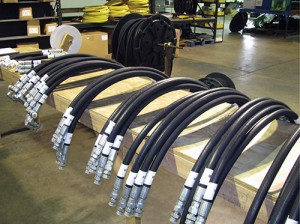(Source: Hose Assembly Tips) Hose whip occurs when a pressurized hose breaks free from its fitting or connection point and whips around violently. This can cause damage to nearby equipment or injury to operators.
Using a hose whip restraint system prevents whipping of a pressurized hose in the event of a hose separation/failure. The systems usually have two parts: a hose collar and a cable assembly. A collar is selected based on the outside diameter of the hose, while the cable assembly is chosen based on the type of hose connection.
While restraint systems are useful, they should not be used in place of proper hose crimping procedures.
Other preventative measures to take when dealing with hose whip include:
- Inspect hoses for torn outer jackets, damaged inner reinforcing or soft spots before using them
- Reduce the pressure in the hose to a lower level if possible; setting pressure regulators to 30 psi or less can minimize the possibility of the hose whipping
- Avoid sharp bends in the hose, which can damage the reinforcement
- Don’t jerk on a hose that has become snagged, as this can cause ruptures
- Restrain pressurized hoses that are unavoidably located near other employees with guards strong enough to keep the hoses in place if a leak or rupture occurs
- Use solid lines with tight fittings, if possible, instead of flexible hoses when working near other employees
- Examine the connections on pressurized hoses frequently to prevent any accidental detachment of the line, which would result in uncontrollable whipping
- Pin the two sides of the hose’s twist type fitting together using the lugs provided. Be sure these fittings are fully secured
- Use the safety device at the air supply to reduce the pressure in the event of a hose failure; this device is standard on all hoses that are ½ in. in diameter or larger
- Never connect or disconnect pressurized hoses, always depressurize first
- Don’t stop the airflow in a hose by bending or crimping with pliers as this could cause major hose damage
- Stand clear of potential rupture points when conducting hose pressure tests
- During testing, the pressure should be increased gradually with a brief pause between each increase; instruments for reading pressures should be arranged so they are clearly visible at all times.
Source: Hose Assembly Tips

